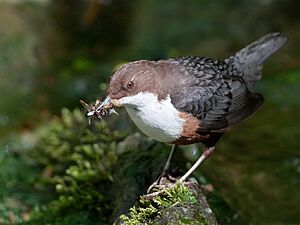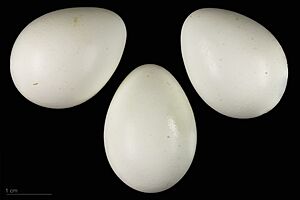White-throated dipper facts for kids
The white-throated dipper (Cinclus cinclus), also called the European dipper or simply dipper, is a special bird that lives near water. It's a type of passerine bird, which means it's a perching bird. You can find these birds in Europe, the Middle East, Central Asia, and the Indian Subcontinent. There are different kinds of white-throated dippers, called subspecies, mainly recognized by the colors on their chests.
Quick facts for kids White-throated dipper |
|
|---|---|
 |
|
| In Kirkcudbright, Scotland | |
| Conservation status | |
| Scientific classification | |
| Genus: |
Cinclus
|
| Species: |
cinclus
|
 |
|
| Range of C. cinclus Resident Non-breeding Extinct | |
| Synonyms | |
|
Sturnus cinclus Linnaeus, 1758 |
|
Contents
Discovering the Dipper's Family Tree
The white-throated dipper was first officially described in 1758. A Swedish scientist named Carl Linnaeus gave it the scientific name Sturnus cinclus. This was in his famous book, Systema Naturae.
Later, in 1797, another scientist named Moritz Balthasar Borkhausen gave it its current group name, Cinclus. The word cinclus comes from an old Greek word. It was used for small birds that wagged their tails near water. Scientists have studied the dipper's genes. They found that the white-throated dipper is most closely related to the brown dipper. This other dipper lives in Asia.
Different Kinds of Dippers: Subspecies List
There are 14 known types, or subspecies, of the white-throated dipper. One of these types is now extinct. Here are some of them:
- C. c. hibernicus: Found in Ireland and western Scotland.
- C. c. gularis: Lives in most of Scotland, northern, central, and western England, and Wales.
- C. c. cinclus: Found in northern Europe, France, northern Spain, Portugal, Corsica, and Sardinia.
- C. c. aquaticus: Lives in central and southern Europe.
- C. c. olympicus: This type used to live in Cyprus but is now extinct.
- C. c. minor: Found in northwest Africa.
- C. c. rufiventris: Lives in western Syria and Lebanon.
- C. c. uralensis: Found near the Ural Mountains.
- C. c. caucasicus: Lives from Turkey to the Caucasus, northern Iran, and northern Iraq.
- C. c. persicus: Found in southwest Iran.
- C. c. leucogaster: Lives in south-central Russia, northwest China, Afghanistan, and northern Pakistan.
- C. c. baicalensis: Found in south-central and southeast Siberia.
- C. c. cashmeriensis: Lives in the western and central Himalayas.
- C. c. przewalskii: Found in the eastern Himalayas, southern Tibet, and western China.
What Does a Dipper Look Like?
The white-throated dipper is about 18 centimetres (7.1 in) long. It has a round body and a short tail. Adult dippers have a brown head. Their back is a dark gray color with black spots. From far away, their back looks black. Their wings and tail are brown.
The dipper's throat and upper chest are white. Below the white, there's a band of warm brown color. This brown band blends into black on their belly and sides. Their beak is almost black, and their legs and eyes are brown. One type, C. c. cinclus, has a black band on its belly. Young dippers are grayish-brown and do not have the brown chest band.
The Dipper's Song and Calls
Male dippers sing a sweet song. It sounds a bit like the song of a Eurasian wren. When a male dipper is trying to attract a mate, he sings while running and showing off his white chest. He might also fly high and far, like a common kingfisher. While flying, he makes sharp, metallic calls that sound like clink, clink. This is different from his usual zil call.
How Dippers Live: Behavior and Ecology
White-throated dippers love fast-flowing rivers and streams. They also live near lakes where these streams flow in. You'll often see them perched on rocks in the water. They bob up and down quickly, with their short tails pointing up. This bobbing motion is how they got their name. It's not because they dive, even though they do dive!
Flying and Diving Skills
Dippers fly very fast and straight. Their short wings whir quickly without stopping or gliding. As they fly, they make a sharp zil, zil, zil sound. They can then drop onto the water and dive in. Sometimes, they just plunge into the water with a small splash.
From a rock, a dipper can walk right into the water. It will deliberately go completely underwater. It's not true that they can walk along the bottom like magic. When they enter the water, they grip with their strong feet. But to move underwater, they actually swim. They use their wings to "fly" underwater. They hold themselves down by using their muscles. Their head is down, and their body is at an angle. You can often see a line of bubbles showing where they are swimming underwater.
What Do Dippers Eat?
Dippers find their food underwater. They usually eat small water bugs, like caddis worms and other insect larvae. They also eat beetles, freshwater snails, and other small molluscs. Sometimes, they catch small fish and tiny amphibians. A favorite food is a small shrimp-like creature called Gammarus. Dippers also walk and run on the riverbanks and rocks. Here, they look for bugs that live on land. Sometimes, bigger fish like brown trout might try to eat dippers.
Winter Habits
What dippers do in winter can be different for each bird. If the fast mountain streams freeze over, they have to move to lower areas. They might even go to the coast. But some dippers will stay if there's any open water left.
The Dipper's Life Cycle: Reproduction
White-throated dippers start having babies when they are one year old. They usually have one partner and protect their nesting area. Their nest is almost always built very close to or right above the water. They often place it on a rocky ledge or in a small cave. They also use human-made places like bridges.
Building the Nest
The nest is shaped like a dome. It's made of moss, grass stems, and leaves. It has an entrance on the side. Inside, there's a smaller cup made of stems, tiny roots, and hair. Both the male and female dippers build the main, larger part of the nest. But the female builds the inner cup.
Eggs and Chicks
The female lays one egg each day. A clutch can have from 1 to 8 eggs, but usually 4 or 5. The eggs are smooth, shiny, and white. They are about 26 mm × 18.7 mm (1.02 in × 0.74 in) in size. The female sits on the eggs to keep them warm. She usually starts after the last egg is laid, or sometimes after the second to last. The male dipper brings food to the female while she is sitting on the eggs.
The eggs hatch after about 16 days. Once the chicks hatch, both parents feed them. For the first 12 to 13 days, the female keeps the chicks warm. Both parents also remove the chicks' waste for the first 9 days. The young birds leave the nest when they are about 22 days old. But their parents continue to feed them for another week, sometimes up to 18 days. If the female starts laying a second set of eggs, then only the male feeds the young birds that have left the nest. Dippers usually have one or two groups of chicks each year, often in the same nest. If young dippers are disturbed, even if they barely have feathers, they will immediately drop into the water and dive.
The oldest white-throated dipper ever recorded lived for 10 years and 7 months. This bird was tagged in Finland. In the United Kingdom and Ireland, the oldest recorded dipper lived for 8 years and 9 months.
Dippers and People
The first detailed description of the white-throated dipper was written around 1183. It was by Gerald of Wales, a historian and traveler from the 12th century. He wrote about it in his book Topographia Hibernica, which described his travels in Ireland. Gerald was good at observing animals. He described the dipper very accurately. However, he also believed many stories he was told. He thought the dipper was a strange type of common kingfisher. He believed that true kingfishers didn't live in Ireland back then.
The white-throated dipper is the national bird of Norway.
Gallery
-
From Jung town in Arunachal Pradesh in eastern Himalayas India
-
Eggs, Collection Museum Wiesbaden, Germany







